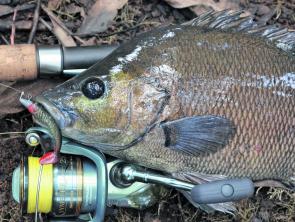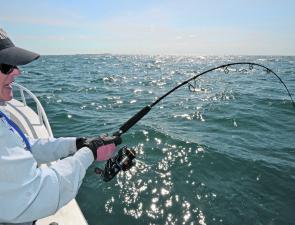This month I continue my four-part examination of the critical, but often-overlooked, subject of spooling up your reels with line by offering some thoughts on exactly how much line you’ll need for optimum fishing performance.
For most common forms of fishing undertaken in Australian waters, you’ll need somewhere between 100-500m of line on your reel. The only major exceptions are bluewater game fishing and deep-dropping along the edge of the Continental Shelf for the likes of blue-eye trevalla, bar cod and hapuka, where you’ll possibly need even more line on the spool.
The packaging that came with your reel when you bought it should have indicated roughly how much line of a particular strength or thickness the reel is capable of holding, and some threadline (spinning) reels, in particular, also have this information printed on the exposed spool flange or skirt. Remember, however, that this info’ is only intended as a guide. Also, it typically refers to the reel’s capacity for holding nylon or fluorocarbon monofilament line so it’s not particularly useful when dealing with the modern fused or braided gel-spun polyethylene (GSP or PE) ‘super lines’ that are so popular today. A few reel makers nowadays do also quote nominal capacities for braided lines.
How much line you can actually fit onto any reel’s spool is primarily dictated by the line’s thickness and how tightly you tension it while spooling up. However, perhaps the most vexing question of all when spooling up is exactly when to stop! Reels that are either under-filled or over-filled with line tend to perform poorly and can create major problems while fishing.
An over-filled spool can spill loose line and create tangles (especially on spin reels or threadlines). It may even cause the line load to rub or jam against the reel’s frame (especially in the case of overheads, baitcasters and fly reels).
On the other hand, under-filled spools significantly reduce average casting distances, reduce your actual retrieve speed and potentially impact adversely upon drag performance. Of course, too little line can also be absolutely disastrous if you hook a really big, strong and long-running fish!
What we’re looking for when spooling up any reel is the Goldilock’s level – when it’s ‘just right!’
When considering exactly how much line to pack onto your reel, always remember that you can more easily take a little excess line off an over-filled spool than put more on an under-filled one — especially after you’ve cut the line! So, if in doubt, err on the slightly over-filled side rather than stopping short.
If the reel you’re using is one that allows the line to peel off over the lip or edge of the spool during a cast (as with threadline or spin reels, sidecasts and closed-face reels), it’s especially important to make sure the spool is well-filled. With these reels, too little line has the result of dramatically sand-bagging your casting distance, and principally your ability to effectively use lightweight sinkers or lures.
The design of these popular reels requires you to fill the spool until the line load is just a millimetre or two below the actual spool lip for optimum results. However, the advent of modern gel-spun polyethylene (GSP or PE) lines, with their thin diameters and slippery finishes, has made this a tad less critical, and there are actually sound arguments for not filling spools to quite the same level with these ‘super lines’.
Over-filling with braid can be particularly annoying in terms of casting knots and snarl-ups, often caused by loose loops spilling off the spool and wrapping together during a cast.
It’s also very important that the profile or shape of the actual line load on your spinning reel is neat and even. If it tapers at all, then it should be ever so slightly narrower at the back (towards the rear of the reel) than the front, as this will reduce casting tangles. The opposite taper (wide at the back and narrower at the front) is bad news.
Most good spin reels sold these days come with a couple of extra washers or shims in the box that can be placed on the spool shaft behind the spool to adjust this line load profile. Don’t be afraid to add or subtract these washers until the line load is even and neat, with a very slight bias towards the front.
Of course, from the moment you fill your reel with new line, the diametre of that line load will begin to drop as you tie knots, construct rigs and inevitably lose line to snags and tangles. As this line level falls, so will the efficiency of your reel. Knowing when to re-spool or top up (top-shot) with fresh line is important, and a subject we’ll examine in detail next month, in the final instalment of this vital series on spooling up.
Next month: Replacing, reversing and top-shotting your line loads.
Reads: 4802
Having spin reels filled to their optimum level is particularly important when casting lighter lures and sinkers, such as the small soft plastic used to fool this chunky sooty grunter. The line load on this little eggbeater is just about perfect for fine

A big fish is hooked and running hard – will there be enough line on the spool to slow and stop that first long run?

A big blue salmon taken from the beach on relatively light spinning tackle. Casting lightweight minnows and other hardbodied lures over longer distances demands a reel that’s filled with line to the optimum ‘Goldilocks’ level.




